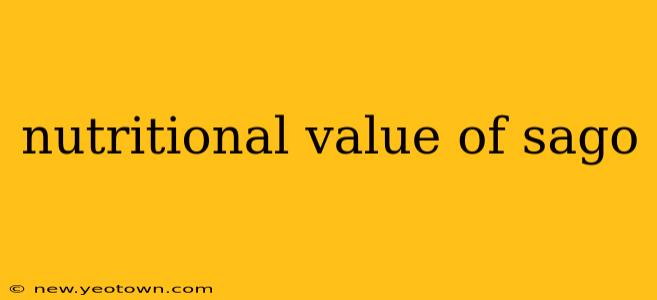Sago. The very word conjures images of creamy desserts, delicate puddings, and perhaps even a slightly mysterious air. But beyond its culinary appeal lies a surprisingly nuanced nutritional profile that often gets overlooked. This isn't just a simple starch; understanding its nutritional value requires a closer look. Let's embark on a journey to unravel the mysteries of sago, exploring its composition, benefits, and potential drawbacks.
What is Sago, Exactly?
Before we delve into the nutritional specifics, let's establish a clear understanding of what sago actually is. Sago is a starch extracted from the pith of the sago palm tree ( Metroxylon sagu). This palm, primarily found in Southeast Asia, produces a starchy substance that, after processing, becomes the familiar pearly white pearls we know and love. It's a staple food in many regions, showcasing its versatility in both sweet and savory dishes.
Nutritional Breakdown of Sago: A Closer Look
Sago's nutritional profile is primarily characterized by its high carbohydrate content. It's a significant source of energy, offering a quick boost to fuel the body. However, it’s important to note that this energy comes almost exclusively from carbohydrates, with minimal contributions from protein and fat. Here's a general overview (values may vary slightly depending on processing and preparation):
- Carbohydrates: Sago is overwhelmingly composed of carbohydrates, making it a quick source of energy. This makes it important to consume sago as part of a balanced diet.
- Protein: Sago is relatively low in protein, offering minimal contributions to the body's protein requirements.
- Fat: Similar to protein, sago contains negligible amounts of fat.
- Vitamins and Minerals: While not a rich source of vitamins and minerals, sago does contain small amounts of certain nutrients, but not in significant quantities to make it a primary source of micronutrients.
Is Sago a Healthy Food? Exploring the Pros and Cons
The question of whether sago is "healthy" is complex and depends heavily on context. Its high carbohydrate content makes it an energy-dense food, but its low nutritional density beyond carbohydrates raises concerns.
Potential Benefits:
- Quick Energy Source: Sago provides readily available energy, making it a suitable option for quick replenishment after physical activity.
- Versatile Ingredient: Its neutral flavor allows it to be incorporated into a wide range of dishes, offering culinary versatility.
Potential Drawbacks:
- Low Nutritional Value: Sago lacks significant amounts of essential vitamins, minerals, and fiber, meaning it shouldn't form the cornerstone of a healthy diet. Relying heavily on sago can lead to nutritional deficiencies.
- High Glycemic Index: Sago has a high glycemic index (GI), meaning it can cause rapid spikes in blood sugar levels. This is a concern for individuals with diabetes or those seeking to manage their blood sugar effectively.
- Limited Fiber: The lack of fiber in sago can impact digestive health. Fiber is crucial for healthy bowel movements and overall gut well-being.
How Does Sago Compare to Other Starches?
Many people compare sago to other starches like tapioca or rice. While all three are primarily carbohydrates, their nutritional profiles differ slightly in terms of fiber, micronutrients, and glycemic index. Tapioca, for instance, often contains a slightly higher amount of carbohydrates compared to sago, and the same can be true for rice, depending on its type. However, a balanced diet usually incorporates a variety of starch sources to ensure a wider range of nutrients.
Can Diabetics Eat Sago?
H2: Can Diabetics Eat Sago?
This is a crucial question. Due to its high glycemic index, diabetics should consume sago with caution and moderation. It's recommended to incorporate it into a meal plan carefully, factoring in its potential impact on blood sugar levels. Portion control is essential, and combining it with foods that have a lower glycemic index can help mitigate the rapid rise in blood sugar. Always consult with a healthcare professional or registered dietitian for personalized dietary advice tailored to your specific needs.
What are the Best Ways to Incorporate Sago into a Healthy Diet?
H2: What are the Best Ways to Incorporate Sago into a Healthy Diet?
Despite its drawbacks, sago can still be part of a healthy diet when consumed mindfully. The key is moderation and balance. Instead of relying on sago as a primary carbohydrate source, consider it as an occasional treat or a way to add texture and variety to meals. Pair it with nutrient-rich foods, such as fruits, vegetables, and lean proteins, to create a more balanced and nutritious meal.
Conclusion: Enjoy Sago Responsibly
Sago's unique texture and mild taste contribute to its culinary appeal. However, its nutritional value is limited, primarily consisting of carbohydrates. Understanding its high glycemic index and low fiber content is vital for making informed dietary choices. Incorporating sago into a balanced diet, alongside nutrient-rich foods, allows for occasional enjoyment without compromising overall health and well-being. Remember, moderation and mindful consumption are key.

